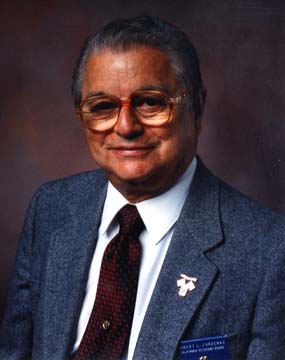 Gen. Robert L. Cardenas was bornMarch 10, 1920, in Merida, Yucatan, Mexico. At age five, he moved to San Diego,Calif., with his parents. He built model airplanes and helped local gliderpilots with dope-and-fabric projects. Being the top student in math and physicsat his high school earned him a two-year pre-engineering scholarship to SanDiego State University. His military career began in 1939 when he became amember of the California National Guard. He entered aviation cadet training inSeptember 1940 and received his pilot wings and commission as second lieutenantin July 1941. Cardenas was sent to Twentynine Palms, Calif., where heestablished a U.S. Army Air Forces glider training school and began his careeras a test pilot. He flew combat in B-24s for the 506th Bombardment Squadron.Shot down over Germany in March 1944, he escaped into Switzerland and then intoFrance prior to D-Day. Returning to Wright Field, he was assigned to the FlightTest Division where he evaluated the Arado 234 — Germany’s first jet bomber —and the XB-42A and the all-jet XB-43. In the summer of 1947 he was designated asofficer-in-charge of operations for the X-1 test team at Muroc and principalproject pilot for the YB-49 flying wing bomber.
Gen. Robert L. Cardenas was bornMarch 10, 1920, in Merida, Yucatan, Mexico. At age five, he moved to San Diego,Calif., with his parents. He built model airplanes and helped local gliderpilots with dope-and-fabric projects. Being the top student in math and physicsat his high school earned him a two-year pre-engineering scholarship to SanDiego State University. His military career began in 1939 when he became amember of the California National Guard. He entered aviation cadet training inSeptember 1940 and received his pilot wings and commission as second lieutenantin July 1941. Cardenas was sent to Twentynine Palms, Calif., where heestablished a U.S. Army Air Forces glider training school and began his careeras a test pilot. He flew combat in B-24s for the 506th Bombardment Squadron.Shot down over Germany in March 1944, he escaped into Switzerland and then intoFrance prior to D-Day. Returning to Wright Field, he was assigned to the FlightTest Division where he evaluated the Arado 234 — Germany’s first jet bomber —and the XB-42A and the all-jet XB-43. In the summer of 1947 he was designated asofficer-in-charge of operations for the X-1 test team at Muroc and principalproject pilot for the YB-49 flying wing bomber.
On October 14th, 1947, he flew the B-29 carrying the X-1 in which Gen. ChuckYeager broke the speed of sound. Two months later he began flight test work withthe YB-49 Flying Wing. In 1955 Gen. Cardenas completed his degree at theUniversity of New Mexico at Albuquerque with a bachelor of science degree inmechanical engineering. He was assigned to Okinawa, Japan, where he served ascommander of the 51st Fighter Interceptor Group and then as commander of the51st Fighter Interceptor Wing. Following tours as chief of the Aircraft andGuided Missiles Program Division at Headquarters U.S. Air Force and as chief ofthe Special Operations Division at U.S. Strike Command, in Tampa, Fla., hereturned to Okinawa as commander of the 18th Tactical Fighter Wing just beforethe Gulf of Tonkin incident in 1964, and for the next two years he engaged inF-105 combat operations over Southeast Asia. After assignments as commander ofthe 835th Air Division, commander of the U.S. Air Force Special Operations Forceat Eglin Air Force Base, Fla., and vice commander of 16th Air Force, he servedas the U.S. deputy to Live Oak under Supreme Headquarters Allied Powers Europe.As chief of the National Strategic Target List Division of the Joint StrategicTargeting Planning Staff at Offutt Air Force Base, Neb., during his finalactive-duty assignment from 1971-73, he was involved in the development of theU.S. Nuclear War Plan. After retirement from the Air Force, he held a variety ofexecutive positions with industry and was appointed to major advisory and policygroups by President Reagan. He has been active on Veterans’ issues since themid-’80s and just accepted an appointment to a committee on memorials andcemeteries serving under Veterans’ Secretary Anthony Principi, a fellow SanDiegan.
Tell us about your family and where you grew up.
The one serious regret I have is that I didn’t ask my father more questions,so I don’t know too much about my dad. He traveled quite a bit. I do know thathe was born in Mexico and attended schools and universities in the U.S., and wasone of the first to combine engineering with administration. My mother was alsoborn in Mexico, and she died when I was a teenager. So I don’t know as muchabout my relatives as I’d like to. I’m trying hard to pass on as much as I can,so my relatives will know more about me.
My parents brought me to the U.S. when I was five and I grew up in San Diego,in a neighborhood called Little Italy. The families were Italian, Hispanic,Portuguese, Irish, and everybody looked out for one another. There was no racialbias. We didn’t even have to lock our doors and windows — the crooks knewbetter. I was a teenager during the glory days of the tuna fishing fleet, and myfriends and I would go out as helpers on the boats. If you picked the right boat— these were the days before radar and fish-spotting airplanes so you needed acaptain who knew where the fish were — you could come back with $800, which wasa lot of money in the late ’30s.
How did you get interested in aviation?
I went to San Diego High School, and each year Consolidated Vultee — whomade the B-24 — took the top student in math and physics from each of four highschools and sent us to San Diego State college for two years of pre-engineering.At the end of two years they sent one of the four to Cal Tech on a fullscholarship to finish the degree. That’s what I was aiming for. Most of us guysat San Diego State belonged to the 251st Coast Artillery National Guard, andwhen Hitler overran Poland in 1939 they federalized the National Guard. I gotsent to Hawaii, and my CO called me in one day and said "Cardenas, you’rean embarrassment to me. You’re a Corporal with two years of college, and I’vegot officers — other than the West Pointers — who outrank you but don’t haveyour education. Sign these papers." I said "What are they, sir?"and he said "That’s your application for Flying Cadets. You qualify becauseyou have two years of college." I said "Well, sir, flying doesn’tsound too safe. I’m not sure I want to do that." He said "I don’t carewhat you want. Sign the papers so I can get you off my base." So I signedthe papers and a month later I was at Allen Hancock School of Aeronautics inSanta Maria, Calif., as an Aviation Cadet.
I tell that story to high school kids when they ask me how I got into flying.They’re expecting to hear that I was a little kid dreaming about being anaviator. My outfit, the 251st, later went to the Philippines, and many of themwound up on the Battan Death March, and if I had not had two years of college, Imight have been with them. Two years of college may not seem like a lot, but inmy case it might have been the difference between life and death.
I read that someone asked if anyone in the room had any glider experienceand yours was the only hand that went up.
That was at Kelly AFB, where I was a flight instructor. As a teenager in SanDiego I used to help the glider pilots with dope and fabric and I’d get a ridenow and then. I raised my hand because I thought maybe they had an old glider atSan Antonio that they wanted to fly. That’s the first lesson I learned: Don’traise your hand unless you know what’s behind the question! They sent me toTwentynine Palms, California to open up the glider school there.
It’s a vibrant Marine base now. What was there when you got there?
Nothing! A private contractor was hired to build the base, but before thatthe San Diego glider pilots would go out there to fly. You had great thermalsand you could land on the dry lake beds. I was a Second Lieutenant and I was theonly military person there. We had winches and a tow plane, but no gliders. Iremembered reading that the president had appointed Richard DuPont to be theguru of gliders, because the Germans had used gliders.
I had met DuPont so I wrote him a letter. It wasn’t good protocol for a lowlySecond Lieutenant to write to a presidential appointee, but I didn’t know anybetter. I told him that we had a great location, and winches and a tow plane,but no gliders, and that I had a class coming in a few months and I neededsomething for them to fly. I told him if I had $5,000 I could get gliders andinstructors for my class.
About three weeks later a Gooney Bird landed at Twentynine Palms and outstepped a tall, stern-looking Colonel. He took me around to the back of theairplane and said "It’s obvious to me you’re not West Point. If you were,you’d know better than to write over the head of your military superiors to yourcivilian superiors. Did you write a letter to Richard DuPont?" I said"Yes, sir. I needed some gliders and I thought he could get me the money Ineeded." He said "I’m Col. Fred Dent, Jr. and I’m in charge of theglider program, and I brought my checkbook. Go get your gliders."
The first class of 25 officers were trained by Johnny Robinson, Lyle Maxieand some of the best glider pilots in the world.
How did you get from there to flight testing?
Dent went back to Wright Field, and when I made First Lieutenant that’s whereI went. When I get there we moved the glider base from Dayton to Clinton Countyairport in Wilmington, Ohio, and we had the airport to ourselves. Dent broughtin Norm Rintoul and Lloyd Santmyer, who had flown mail planes out of Pittsburghdown the Ohio River for mail delivery to towns without and airport. TheirStinson Reliant is hanging in the Postal Museum in Washington. My job was todevelop methods for towing and recovery, and Rintoul and Santmyer developed asystem for snagging the big CG4A gliders with a C-47. There’s a book — Rescuefrom ShangriLa — about a group of people injured in a plane crash that werelifted out of a remote valley in New Zealand using two CG4A gliders and theyequipment that we developed there at Wilmington.
Was the C-47 a good towplane?
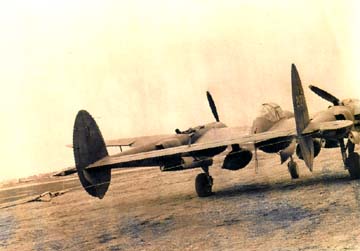 | |
| Double duty. Cardenas towed gliders using a cable attached to each boom of a P-38. A pulley attached to the cable gave the glider pilot the ability to maneuver like a water skier. |
My favorite towplane was a P-38. It had two very powerful engines and thecounter-rotating props meant no torque on takeoff. You could put a plug on eachboom, and a cable between them, and the glider rope rode on a pulley. I towed aCG4A from the factory in Minnesota to Pine Castle, Fla., nonstop using a P-38.I had to convince the General that modifying the P-38 — adding the plugs —didn’t change the combat ability of the airplane. The General said, "I agreethat it’s a better towplane, but we don’t have a lot of them and they cost alot. And we have thousands of C-47s and they don’t cost a lot." That’s whyC-47s became the towplanes instead of P-38s.
Colonel Dent was being sent to Europe, but they wouldn’t send the test pilotsbecause we were "too valuable." Colonel Dent told me if I could get toEurope he’d find a place for me. I got a chance to get to England on a trainingtour, and I went to London and asked them to call Colonel Dent and tell him Iwas here. Dent got on the phone and asked me what I was trying to pull. Ireminded him of our first conversation when he told me I obviously wasn’t a WestPointer, and told him during all the all the years I had flown with him hetaught me that an officer’s word is his bond, and next thing I knew I wasassigned to the 44th Bomb Group, flying B-24s. I wound up in the 506th Squadronuntil I got shot down.
Tell us about that.
It was March 18th, 1944. I wasn’t with my regular group that day. I wascommand pilot so I flew in the lead plane and sat between the pilot and co-pilotwith charts and radio frequencies and alternates. We were over Germany and gotshot up pretty bad, and the pilot said, "Let’s head for Switzerland and hopewe make it." I packed up my papers, headed for the bomb bay and startedshredding the classified papers. When the bomb bay door opened I jumped and Ilanded right on the shores of Lake Constance — between Germany and Switzerland.I was a pretty good swimmer so I swam for the Swiss side. A Swiss family took mein and eventually I was interned by the Swiss police. I listened to LordHaw Haw on the radio and what he said convinced me to try and get out ofSwitzerland.
There were three kinds of Swiss prisoner. If you landed your airplane inSwitzerland you were interned, and the Swiss police were bound to shoot you tokeep you from escaping. If you landed in Germany and escaped from the Stalagluftinto Switzerland, you were an escapee, and they still interned you and theGermans still had the right to shoot you. I was the third type — an evadee. Ihad landed in Germany but had evaded the Germans. The Swiss would try to keepme, but they couldn’t object if I left. At the Geneva train station there weretwo sets of tracks — one for trains inside Switzerland and the other for trainsleaving Switzerland. There was a cafe between the two sets of tracks, and withthe help of the underground I posed as a waiter, hopped a train and escaped intoGrenoble, France, in a boxcar filled with Indian Sikhs.
Pretty soon D-Day came and the local underground arranged for me to get toEngland. Then they sent me back to the States, then back to Wright Field. Thistime I was in Flight Test Division, Bomber Section.
What were we trying to achieve that the B-24 couldn’t do?
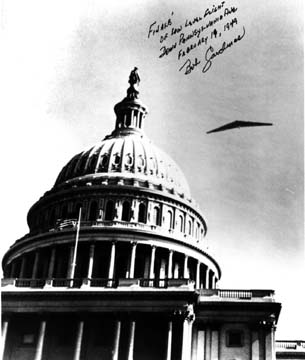 | |
| "Finale of low level flight down Pennsylvania Ave. on February 19, 1949." |
Early in the war we knew that if England fell, we wouldn’t have air support inthe field, and we could lose the war. So we wanted a bomber that could fly10,000 miles carrying 10,000 pounds of bombs. That’s what the B-36 was designedfor. I never flew the B-36, and I thought it was odd to put a whirling propelleron the trailing edge of a wing. I thought because there are two different airmasses there you might have blade flutter, and gear and engine problems, andthat’s what happened.
Then Jack Northrop came up with the flying wing. It was a beautiful concept,because by getting rid of the fuselage and the tail you got rid of a third ofthe drag, so you could go farther on the same amount of fuel. Max Stanley, theNorthrop test pilot, did fly a flight pattern of 10,000 miles carrying 10,000pounds. By that time, WWII had ended and the push for 10 and 10 had stopped.
How did you get from Wright Field in Ohio to Muroc in California?
In 1947 Colonel Al Boyd put me in charge of the X-1 project at Muroc. Theycalled me various things — Administrative Officer, Operations Officer, Officerin Charge — but my instructions were on one piece of paper. The first paragraphsaid "The project will be progressive and will be brief." The secondparagraph said, "Safety of flight is paramount but is not to impede successof the project." So from July ’47 to October — when Chuck broke the soundbarrier — I was busy with that, and flew my first flight in the YB-49 inDecember of ’47. Their vision was born from the fear of England falling, but theflying wing was a visionary concept, as we’re seeing with the B-2 taking off inMissouri and flying about 10,000 miles to bomb Afghanistan.
It was fun to fly. Your turns rotated about a wingtip, not the centerline ofthe aircraft. Landing the airplane was difficult, because in ground effect youwere surfing on air, but you could use both rudders at the same time and getpretty good at spot landings. It was not unstable, but it had demonstratedmarginal stability about all three axes. The first time I took off, I blew thegear doors off. So after that I had two choices, either steepen the climb orreduce power. You hate to reduce power on takeoff, so I steepened the climb.Then, when you leveled off, you sat and rocked back and forth in unison with thefuel sloshing in the tanks.
It’s a bomber, so when you rolled out on the bomb run, it developed a phugoidoscillation — which would eventually dampen out — but in the process wouldlengthen your bomb run which decreased your degree of survivability. I’m notblaming Mr. Northrop or his engineers. They didn’t have much experience withjets.
Tell us about how you recovered from a stall.
Paul Bickell, who was a brilliant engineer in charge of flight testengineering, wanted to get a full-wing stall, instead of having it just fall offon a wing. So instead of just using the wheel to control the elevons, Bickelltold me to trim the airplane as I got slower, because as you trimmed the ruddersmoved on a hinge and acted like a trim tab. I trimmed as it got slower, and Iwaited for the burble, but instead of burbling it went over backwards andstarted tumbling over backwards. The engineers don’t like to use the word"tumble." They called it a lateral roll.
The G forces put my rear end in the air, my feet off the rudders, and myhands in the air. There was no seat ejection — you got out the same way youclimbed in, through a door in the belly. Instead of putting the throttles byyour knees — where they belong — the designers put them in the ceiling — likea PBY. My hands were locked in the air, and I was able to reach over and applyfull throttle to the four engines on the left side, and that broke the tumble.It put me into an inverted spin, which I knew how to get out of. I recoveredabout 800 feet above the ground. I wrote a one-page report saying that theairplane should be placarded against any voluntary stalls.
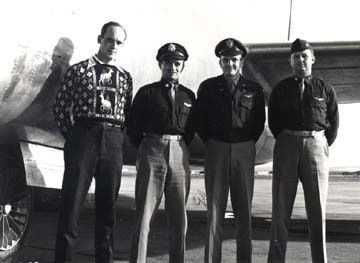 | |
| Dick Schmidt and Los Tres Amigos: Bob Cardenas, Glen Edwards and Danny Forbes |
There were two factions at work during all of this. Max and I were on the samepage, and on the other side was the company who wanted to sell airplanes. Thecompany would not accept the fact that it had tumbled. They asked Max Stanley todo a stall series and he declined. They got Charlie Tucker to do stalls, butsince he didn’t trim it like I did, he got a wingtip stall and didn’t go overbackwards. In May I was just about finished with the performance phase of thetesting, and I got a chance to go USC and finish my engineering degree. So Boydgot GlenEdwards — who had helped Dr. Perkins write the book on stability andcontrol — to take my place. I checked Glen out on May 20th and 21st [’48], andI drove to Dayton, picked up my sweetheart, and got married.
On the 5th of June, I was taking my bride to meet my parents and I heard onthe radio that the wing had crashed. So I did a 180 and went to Muroc. Boyd toldme that he had cancelled my school orders and told me to finish the testing andfind out what happened to Glen.
What’s your theory?
The airplane was designed for 210,000 pound gross weight, but we had neverflown it above 170,000 pounds. I think that Glen got into a high-speed stall,and as inertialcoupling took over it left him with no control and no method of escaping.
The last gasp was February 9th, ’49, when I flew the airplane nonstop fromMuroc to Andrews AFB for what they called "President Truman’s Airshow."From takeoff to over the field was 4:05, but by the time I made a couple ofpasses it was 4:20. They wanted to beat the record of the B-47. We had anairplane designed for .78 mach, and the B-47 was designed for .82 mach and eventhen it was close, the B-47 got there in 3:47.
We had it parked on the ramp, and Truman came up in the cockpit and said tothe Chief of the Air Force "General, it looks pretty good to me. I thinkI’m going to buy some of these."
I had already written a report — which they deep-sixed — and said that theairplane was not a suitable operational bomber, so I had to bite my tongue. ThenTruman said "Let’s have this whippersnapper fly this thing downPennsylvania Avenue." So my boss told me "Bob, go fly this thing downPennsylvania Avenue, and don’t hit anything!" and I did. PennsylvaniaAvenue is lined with trees, and there were some tall radio towers that werehidden by the trees. The White House is also hidden by trees. I slowed it toabout 350 miles per hour and flew a low pass down Pennsylvania Avenue lookingcarefully for towers. Next thing I knew I looked up and the Capitol dome wasstraight ahead and I had to pull up to miss it.
On the way home we had an engine fire crossing the Rockies. My navigator saidWinslow, Ariz., was the closest airport we could get to, and by the time welanded at Winslow six engines were on fire and we were down to two engines. Welanded there, and they came out with new engines and we flew it back to Muroc.
And still they wouldn’t quit. Boyd told me that he had to schedule one moretest pilot to double-check my report and Glen’s report. He sent Russ Schlee out,the nosewheel collapsed, Pete Sellers practically lifted Russ out through thehole. The airplane caught fire and burned and that was the last one. Somewriters tried to sensationalize it by saying that Schlee had been deliberatelysent out to destroy the last airplane. There are a lot of books about the B-49,and Gary Pape’s book is the only one thatdoesn’t give the Northrop company line.
Have you flown or ridden in the B-2?
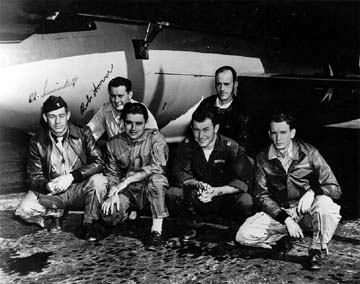 | |
| The X-1 Team: Lt. Edward Swindell (B-29 flight Engineer); Lt. Bob Hoover (X-1 backup pilot and chase pilot); Maj. Bob Cardenas (officer-in-charge and B-29 drop pilot); Capt. Chuck Yeager; Dick Frost (Bell X-1 project engineer and chase pilot) and Capt. Jackie Ridley (Air Force X-1 project engineer), |
I haven’t flown it. I’ve been to Palmdale and sat in it. They say the airplane’sexpensive, but you have to look not just at the airplane but at the system. TheB-2, with a crew of two, can carry — it’s classified, but let’s say 40,000pounds of bombs — halfway around the world in less than 10 hours. I’m not aNavy person, so I don’t know what a fighter/bomber can carry, but it takes awhole aircraft carrier to support that fighter/bomber. So once you startcomparing systems, you get a different picture.
The B-2 is proving itself in this current war, and it’s proving the visionthat started 50 years ago.
Let’s go back to the fall of ’47. How much wrong stuff was in "TheRight Stuff?"
It was Hollywoodized. Chuck never turned to Jackie and said "Let’s gobreak the speed of sound today."
We did do it in a hurry — from July to October. We had been told"Progressive and brief."
My job was to keep things running and to keep the NACA off our backs. Theywere very jealous of that project having been militarized, and they called us abunch of cowboys. But we needed them out there because they had the telemeteringequipment.
Bob Hoover usually flew high chase. Dick Frost was a Bell engineer who wasalso a pilot, and he usually flew low chase and he would pass his technicalknowledge to Jackie Ridley. It was Dick’s idea to put the 3g load onhorizontally instead of vertically.
The other things that made NACA’s blood boil was when we rolled the airplaneinto the hangar at night and made a modification. Since the airplane operatedusing 5,000 PSI gas pressure — it didn’t have hydraulic or electrical systems— we put an air motor at the top and an air motor at the bottom so we couldmove the whole stabilizer with a worm gear. That was unheard of in NACA circles.
Jackie was the brains of the outfit, who would pass it to Chuck. Jackie couldtalk to Chuck. These days you hear Chuck speak and he sounds articulate. Backthen, fresh from the hills of West Virginia, I couldn’t understand him. He andJackie, who was from Oklahoma, could understand one another.
One night I got an anonymous phone call from a guy who told me he knew Yeagerhad an important flight the next morning and he would rest easier if I knew thathe had just taped his ribs.
You still don’t know who that was?
Nope. He never has fessed up.
Bob Hoover was the alternate pilot. I knew I had the responsibility and theauthority to move Bob in and Chuck out. Hoover was equally as good a pilot asfar as stick-and-rudder goes. But sometimes Hoover would do everything right andthe result wasn’t what you wanted. And I had watched Chuck, and when Chuck gotinto that airplane he was no longer a human being. He became part of thatairplane, or the airplane became part of him.
The next morning the NACA guy asked me "How’s Chuck feeling?" and Isaid "Fine, I guess. Why?" He said "I heard he got hurt."and I shrugged and said "I haven’t heard anything." I knew right thenthat if he knew about it, he had run right back to Washington and told themabout it, and they no doubt had gone to Boyd and told him about it, so one oftwo things was going to happen. Either the phone was going to ring and Boyd wasgoing to ask me about it, or the phone wasn’t going to ring because maybe Boyddidn’t want to talk to me. So then I decided that if I didn’t hear from Boyd,the only reason I’d change anything is if Chuck couldn’t do it, or didn’t wantto do it. I figured that Chuck had talked it over with Jackie, and when I sawJackie cutting off a piece of a broom handle, I knew why.
Many, many years later I was commanding Special Operations forces at Eglin,and Boyd came through. We had a nice chat — by then I had one star — and Isaid "You never called me that night, but you sent your deputy — ColonelPaul — to ride co-pilot on the B-29. At that time I thought maybe you didn’ttrust me, but then when I tied it together with what you knew about Chuck, itmade sense."
Boyd said, "I had a choice. I could call you and tell you to scrubthings, or I could wait for you to call me. If you called me I’d have to makethe choice, and when you didn’t call me I figured you had decided to take therisk. So I sent my deputy out there to be on that flight." When I sawColonel Paul that morning, I knew that I had done the right thing. In fact, myhand is in the famous picture, but the hand that pulled the lever wasn’t JackieRidley’s, it was Colonel Paul’s.
What’s keeping you busy now?
I’ve been working on Veterans’ issues since 1988. I recently accepted anappointment to a Veterans’ committee and I have a good boss named Robin Higgins.She’s a Marine Lt. Colonel who was married to ColonelHiggins, who was captured, butchered and hanged by the terrorists in Lebanon.She’s the undersecretary for Veterans’ Memorials and Cemeteries under AnthonyPrincipi. Many of our Veterans’ cemeteries are full — Fort Rosecrans here inSan Diego, for instance. Until recently a widow in San Diego had to choosebetween cremation here or a burial in Riverside, about 90 miles north of here.That means a four-hour round-trip funeral procession and a four-hour round-tripfor every visit. So the Veterans’ Memorial Center is working with privatecemeteries so we can put the cemeteries where the Veterans are.
Are you still flying?
Nope. I’ve had open heart surgery and I’m a diabetic. I could stretch it, butwhy? Any kind of flying I would do today would be anticlimactic to what I’vealready done.



































